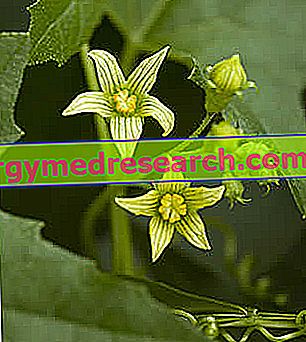What is that
Bryonia is a genus of plants belonging to the Cucurbitaceae family and which includes various species.

Within the genus Bryonia, the most known species are probably Bryonia alba (or white bryony) and Bryonia cretica (or red bryony).
Both plants are toxic and, for this reason, they are not used in phytotherapy. Despite this, according to the principle of "similar care the like", they are exploited in the field of homeopathy.
Please note
When we talk about "Bryonia homeopathic remedy" we usually refer to Bryonia alba . Not surprisingly, this species is the one most used in this area.
In the course of the article the main characteristics of both the aforementioned species will be analyzed.
Bryonia alba
Bryonia alba - also known as the common name of white bryony - is a species native to northeastern and southeastern Europe. The plant is also present in Italy, especially in the northern regions.
Curiosity
Bryonia alba is also known as "devil's turnip" and "English mandrake". Like the mandrake itself, magical properties were also attributed to Bryonia alba .
Features and Botany Description
Bryonia alba is a monoecious plant but produces flowers with separate sexes (that is, in the same plant there are both male and female flowers). The flowers are white-yellowish and the fruits are globose black berries.
The stem is climbing and can reach up to 4 meters in length. The leaves are briefly petiolate, palmate-pentalobate and covered with small hairs on both sides.
The root is large and fleshy, similar to a turnip (hence the name "rapa del diavolo") and a gray-yellowish color. The plant's drug is represented by its root.
Chemical composition
The chemical composition of Bryonia alba is characterized by the presence of various active ingredients, some of which are very toxic. The greatest concentration of these principles is found in the roots, although there are large quantities of them even inside the fruits and the whole plant is considered toxic.
However, the main active ingredients present in the plant root are:
- Triterpene glucosides called cucurbitacine, among which we find the brionine;
- Triterpenes such as brionolic acid;
- Phytosterols;
- Fatty acids;
- Lecithins.
Toxicity and Symptoms of Poisoning by Bryonia alba
The cucurbitacins contained in Bryonia alba have highly toxic and cytotoxic properties.
In detail, ingestion of the plant causes severe irritation of the gastrointestinal mucosa, which is manifested by vomiting and diarrhea. In very high doses, the plant can be lethal.
Other typical symptoms of brionia poisoning are:
- Renal irritation associated with anuria;
- Colic;
- Presence of blood in the stool;
- spasms;
- Paralysis.
The plant is also toxic by contact with the skin and causes severe irritation that occurs with rash, blistering and necrosis.
Use in folk medicine
Given the high toxicity of the plant, its use is not recommended. However, in the past Bryonia alba was used by folk medicine as a laxative and emetic remedy. Indeed, the plant has been used by traditional medicine to treat liver disorders and to treat some infectious, acute and chronic diseases.
Homeopathic remedy Bryonia alba
As mentioned, currently the only permitted use of Bryonia alba concerns its use in homeopathy.
In detail, Bryonia is considered one of the main polychrests in the homeopathic field . This means that Bryonia is a homeopathic remedy able to exert a general rebalancing action and, for this reason, it can be used for the treatment of different types of disorders.
In particular, the Bryonia homeopathic remedy is used in the event of:
- Inflammatory syndromes affecting the gastrointestinal tract, associated with burning and swelling;
- Mucosal dryness;
- Inflammatory states of the mucous membranes that cause acute pain;
- Congestion and inflammation of the respiratory mucosa (laringo-tracheitis) and gastrointestinal (gastroenteritis);
- Inflammations of the serous membranes;
- Fever associated with chills and intense sweating;
- Headache;
- Trigeminal and sciatica neuralgia;
- Dizziness that occurs mainly in the morning;
- Inflammations of the eyes and ocular adnexa;
- Renal inflammation;
- Menstrual pains and disorders (amenorrhea and dysmenorrhea);
- Rheumatic pains;
- Skin disorders.
The Bryonia homeopathic remedy is obtained from the mother tincture of the fresh roots of Bryonia alba (harvested before flowering) by performing appropriate dilutions and dynamizations.
This remedy is available in oral drops or globules in different dilutions. The dilution to be used and the dosage of the product must be established by the homeopath on an individual basis, depending on the type of disorder that needs to be treated and according to its severity.
Bryonia cretica
Bryonia cretica - also known as red bryony - is a species native to central and southern Europe. Considered toxic, its only allowed use is in the homeopathic field.
Did you know that ...
There are two different subspecies of cretic bryony:
- Bryonia cretica subsp. acute, also known as "brionia sicula" because it grows mainly on this island;
- Bryonia cretica subsp. dioica, also known as "common brionia" (in the photo).

Features and Botany Description
Bryonia cretica is a perennial dioecious herbaceous plant. This means that there are plants that have female flowers and plants that have male flowers.
The stem is climbing and reaches sizes ranging from 2 to 4 meters. The leaves are alternate, briefly petiolate, palmate-pentalobate and have small hairs on both pages. The flowers are of a variable color from light green to yellowish.
The fruits are globose red berries (the color of the fruits is one of the main characteristics that distinguishes this species from Bryonia alba ).
The root - which is the plant's drug - is very large, tuberous and light yellow in color.
Chemical composition
The chemical composition of Bryonia cretica is very similar to that of Bryonia alba . Also in this case, the toxic active ingredients are concentrated mainly in the root and in the berries, although the whole plant is poisonous.
However, the main chemical components of Bryonia cretica are:
- Cucurbitacin;
- Triterpenes, among which we find brionolic acid;
- Fatty acids;
- Proteins capable of inactivating ribosomes, such as bryodine (found to be cytotoxic in some in vitro studies).
Toxicity and Symptoms of Poisoning by Bryonia cretica
Similarly to what happens for Bryonia alba, also the toxicity of Bryonia cretica is mainly due to its content of cucurbitacine, triterpene glycosides capable of causing serious irritation of the mucous membranes.
In the event of ingestion, therefore, due to the marked irritation caused to the gastrointestinal mucosa, the plant is able to exert a strong emetic and laxative effect.
Typical symptoms of ingestion by ingestion of Bryonia cretica, are:
- He retched;
- Diarrhea with blood in the stool;
- Renal irritation and anuria;
- Colic;
- spasms;
- Paralysis;
- Abortion in case of ongoing pregnancy.
In severe cases, Bryonia cretica poisoning can lead to death by asphyxiation.
Poisoning treatment
The treatment of Bryonia cretica poisoning involves the emptying of the stomach by gastric lavage (a fortiori if vomiting has not occurred) and the administration of activated charcoal. Spasms due to intoxication can be treated with diazepam and any metabolic acidosis can be counteracted by administering sodium bicarbonate intravenously.
Kidney function should be kept under control and, in case of respiratory problems, oxygen administration and / or patient intubation may be necessary.
Use in folk medicine
Over the years, despite its toxicity, Bryonia cretica has been used in traditional medicine for the treatment of gastrointestinal disorders, liver disorders, metabolic disorders, rheumatic diseases and infectious diseases both acute and chronic.
Homeopathic remedy Bryonia cretica
Bryonia cretica homeopathic remedy is prepared by performing a series of dilutions and dynamizations of the mother tincture obtained from the root of the plant.
The main indications of this remedy concern the treatment of acute and chronic rheumatism, peritonitis and inflammation of the lungs and pleura.
Bryonia cretica homeopathic remedy is available in drops and granules, available at different dilutions. Also in this case, the type of dilution to be used and the dosage of the remedy must be established by the homeopath on an individual basis for each patient, depending on the type and severity of the disorder to be treated.



